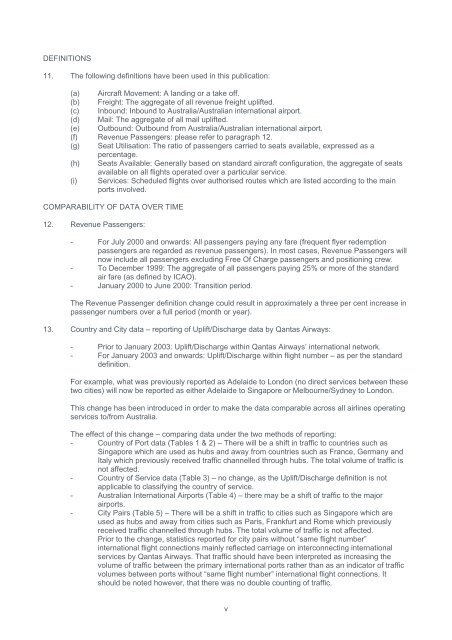PDF: 533 KB - Bureau of Infrastructure, Transport and Regional ...
PDF: 533 KB - Bureau of Infrastructure, Transport and Regional ...
PDF: 533 KB - Bureau of Infrastructure, Transport and Regional ...
You also want an ePaper? Increase the reach of your titles
YUMPU automatically turns print PDFs into web optimized ePapers that Google loves.
DEFINITIONS<br />
11. The following definitions have been used in this publication:<br />
(a) Aircraft Movement: A l<strong>and</strong>ing or a take <strong>of</strong>f.<br />
(b) Freight: The aggregate <strong>of</strong> all revenue freight uplifted.<br />
(c) Inbound: Inbound to Australia/Australian international airport.<br />
(d) Mail: The aggregate <strong>of</strong> all mail uplifted.<br />
(e) Outbound: Outbound from Australia/Australian international airport.<br />
(f) Revenue Passengers: please refer to paragraph 12.<br />
(g) Seat Utilisation: The ratio <strong>of</strong> passengers carried to seats available, expressed as a<br />
percentage.<br />
(h) Seats Available: Generally based on st<strong>and</strong>ard aircraft configuration, the aggregate <strong>of</strong> seats<br />
available on all flights operated over a particular service.<br />
(i) Services: Scheduled flights over authorised routes which are listed according to the main<br />
ports involved.<br />
COMPARABILITY OF DATA OVER TIME<br />
12. Revenue Passengers:<br />
- For July 2000 <strong>and</strong> onwards: All passengers paying any fare (frequent flyer redemption<br />
passengers are regarded as revenue passengers). In most cases, Revenue Passengers will<br />
now include all passengers excluding Free Of Charge passengers <strong>and</strong> positioning crew.<br />
- To December 1999: The aggregate <strong>of</strong> all passengers paying 25% or more <strong>of</strong> the st<strong>and</strong>ard<br />
air fare (as defined by ICAO).<br />
- January 2000 to June 2000: Transition period.<br />
The Revenue Passenger definition change could result in approximately a three per cent increase in<br />
passenger numbers over a full period (month or year).<br />
13. Country <strong>and</strong> City data – reporting <strong>of</strong> Uplift/Discharge data by Qantas Airways:<br />
- Prior to January 2003: Uplift/Discharge within Qantas Airways’ international network.<br />
- For January 2003 <strong>and</strong> onwards: Uplift/Discharge within flight number – as per the st<strong>and</strong>ard<br />
definition.<br />
For example, what was previously reported as Adelaide to London (no direct services between these<br />
two cities) will now be reported as either Adelaide to Singapore or Melbourne/Sydney to London.<br />
This change has been introduced in order to make the data comparable across all airlines operating<br />
services to/from Australia.<br />
The effect <strong>of</strong> this change – comparing data under the two methods <strong>of</strong> reporting:<br />
- Country <strong>of</strong> Port data (Tables 1 & 2) – There will be a shift in traffic to countries such as<br />
Singapore which are used as hubs <strong>and</strong> away from countries such as France, Germany <strong>and</strong><br />
Italy which previously received traffic channelled through hubs. The total volume <strong>of</strong> traffic is<br />
not affected.<br />
- Country <strong>of</strong> Service data (Table 3) – no change, as the Uplift/Discharge definition is not<br />
applicable to classifying the country <strong>of</strong> service.<br />
- Australian International Airports (Table 4) – there may be a shift <strong>of</strong> traffic to the major<br />
airports.<br />
- City Pairs (Table 5) – There will be a shift in traffic to cities such as Singapore which are<br />
used as hubs <strong>and</strong> away from cities such as Paris, Frankfurt <strong>and</strong> Rome which previously<br />
received traffic channelled through hubs. The total volume <strong>of</strong> traffic is not affected.<br />
Prior to the change, statistics reported for city pairs without “same flight number”<br />
international flight connections mainly reflected carriage on interconnecting international<br />
services by Qantas Airways. That traffic should have been interpreted as increasing the<br />
volume <strong>of</strong> traffic between the primary international ports rather than as an indicator <strong>of</strong> traffic<br />
volumes between ports without “same flight number” international flight connections. It<br />
should be noted however, that there was no double counting <strong>of</strong> traffic.<br />
v

















